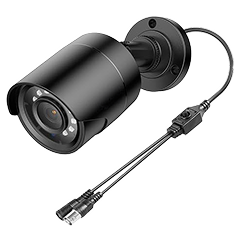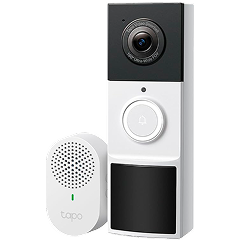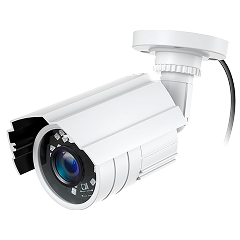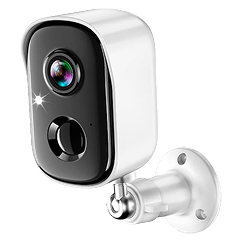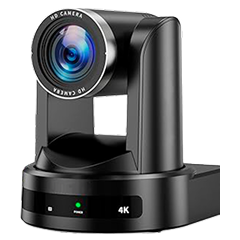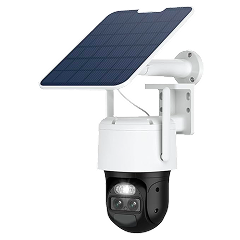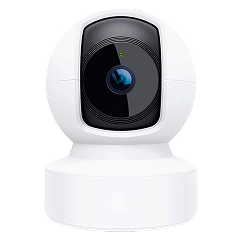Después de tres años usando cámaras Ring en mi vivienda, he aprendido exactamente en qué puntos fallan los sistemas inalámbricos. Mi sistema Ring funciona bien para lo que es: tiene una calidad de vídeo aceptable y una instalación sencillísima, pero las limitaciones se hacen evidentes una vez que vives con estas cámaras.
Entre ellas están las interrupciones del Wi-Fi cuando mi familia reproduce vídeos, y la dependencia total de la conexión a Internet para las funciones básicas. Por eso, le pedí a mi constructor que colocara cables Ethernet en ubicaciones estratégicas durante la construcción e invertí en una puerta de enlace UniFi para la mejora prevista de una cámara PoE.
Las cámaras con cable eliminan los principales problemas de los que no pueden escapar los sistemas inalámbricos: gestión de la alimentación, competencia por el ancho de banda y lagunas de fiabilidad. Cuando mi Internet se cayó durante seis horas el invierno pasado, mis cámaras Ring se convirtieron en costosos adornos de jardín, ya que no podían grabar a nivel local.
Un sistema cableado correctamente diseñado con almacenamiento local habría seguido funcionando. Esta guía cubre las cuestiones relativas a las cámaras PoE y con cable que son importantes para instalaciones permanentes: requisitos de infraestructura, ventajas de rendimiento y especificaciones técnicas que hacen que merezca la pena la complejidad adicional de los sistemas con cable.
Power Over Ethernet: los cimientos de los sistemas por cable
PoE elimina los quebraderos de cabeza de la gestión de la alimentación que me han frustrado con las cámaras inalámbricas, pero elegir el estándar PoE adecuado marca la diferencia entre un sistema que funciona y otro que te decepciona.
Normas y requisitos de PoE
Las cámaras que elegí para mi sistema UniFi exigían todas PoE+ a 25,5 vatios en lugar de los 15,4 vatios de PoE estándar. La PoE estándar funciona bien para cámaras sencillas, pero si añadimos luces infrarrojas, motores de giro/inclinación o calefactores para climas fríos, los límites de potencia se alcanzan rápidamente. Tuve que comprar un conmutador capaz de suministrar PoE+ a seis puertos a la vez, algo que me hubiera gustado saber antes de enamorarme de las cámaras que necesitaban esa potencia extra.
Planificación de la infraestructura de instalación
Instalar Ethernet durante la construcción fue una de las decisiones más inteligentes que tomé, aunque no vaya a instalar las cámaras hasta dentro de uno o dos años. Instalar cables en paredes acabadas, sobre todo en lugares óptimos para colocar las cámaras, como los aleros del segundo piso, se convierte en una pesadilla de reparación de paneles de yeso y opciones de montaje limitadas.
Instalé cables Cat6 en seis ubicaciones por todo el perímetro de la casa, cada una de ellas con conductos independientes para evitar problemas de interferencias. La clave está en planificar las posiciones de las cámaras antes de montarlas, de modo que puedas dirigir los cables a través de las paredes en lugar de a lo largo de los zócalos o a través de conductos expuestos que dan un aspecto poco profesional.
Opciones alternativas a la alimentación por cable
Algunos sistemas de cámaras usan líneas de alimentación de CC de bajo voltaje independientes en lugar de PoE, lo que te brinda más flexibilidad a la hora de elegir la cámara, pero añade complejidad a la instalación. Sin embargo, tendrás que contratar a un electricista para que instale los transformadores y el cableado necesarios para alimentar este tipo de cámaras.
Resolución de vídeo y rendimiento de la calidad de imagen
Las cámaras con cable ofrecen la calidad de vídeo que prometen los sistemas inalámbricos, pero que no pueden mantener de forma constante, especialmente cuando necesitas esa grabación para fines de identificación real.
Capacidades de resolución con alimentación dedicada
La alimentación constante permite a las cámaras con cable ofrecer de verdad sus especificaciones 4K sin los inconvenientes que he tenido con mi sistema Ring. Esto es lo que cambia con la alimentación dedicada:
- Transmisiones en 4K: se acabaron las pérdidas de fotogramas durante los picos de uso de la red, como me ocurre con las cámaras Ring a la hora de cenar.
- Grabación a 60 FPS: capturas de movimiento fluidas que permiten identificar sujetos en rápido movimiento.
- Velocidades de bits constantes: no hay pérdidas de calidad cuando se agota la batería o se satura la Wi-Fi.
- Grabación extendida: la grabación continua es posible sin reducir la duración de la batería.
Mis cámaras Ring afirman que graban a 1080p, pero ves cómo se reduce la calidad cuando la Wi-Fi se satura a la hora de ver Netflix. Las cámaras con cable no se andan con estos juegos; ofrecen sus especificaciones nominales de forma constante porque la alimentación nunca fluctúa, y no están peleándose con otros dispositivos por el ancho de banda de la red inalámbrica.
Rendimiento del sensor de imagen
Las cámaras que funcionan con batería aceleran sus sensores CMOS para ahorrar energía, lo que acaba con la calidad de imagen con el tiempo. Las cámaras con cable funcionan con sus sensores a pleno rendimiento de forma constante; la ausencia de ahorro de energía se traduce en una precisión del color y un rendimiento con poca luz constantes. Las funciones como la visión nocturna en color realmente funcionan cuando tienes una potencia de procesamiento ilimitada en lugar de tener que racionar cada vatio.
Estándares de compresión y compensaciones de calidad
H.265 crea archivos más pequeños con mejor calidad que el H.264 que usan mis cámaras Ring, pero codificar H.265 consume potencia de procesamiento de la que las cámaras con batería no pueden prescindir. Ring utiliza H.264 para preservar la duración de la batería, lo que significa archivos más grandes y mucho más ancho de banda con peor calidad. Las cámaras con cable pueden quemar los ciclos de procesamiento adicionales que exige H.265, y eso importa cuando almacenas semanas de metraje continuo en lugar de clips de movimiento cortos.
Visión nocturna y alcance de iluminación
La potencia ilimitada hace que la visión nocturna deje de ser una ocurrencia de última hora que agota la batería y se convierta en algo con lo que realmente puedes contar cuando aparezcan problemas al anochecer.
Rendimiento de los LED infrarrojos
Las cámaras con cable pueden ofrecer una gran potencia de infrarrojos sin tener que preocuparte por que se agote la batería. Las cámaras de Ring afirman tener una visión nocturna aceptable, pero las versiones que funcionan con pilas reducen la intensidad de los LED para ahorrar batería, con lo que obtienes imágenes granuladas a partir de los 4,5 metros. Las cámaras profesionales con cable con rangos de visión nocturna de más de 30 metros no son una ficción de marketing cuando tienen alimentación exclusiva para alimentar matrices de LED de alta potencia.
Sin embargo, la posición es más importante que el número de luces LED. Las cámaras con luces infrarrojas repartidas por todo el perímetro del objetivo eliminan los puntos calientes y las sombras que afectan a los diseños más baratos con LED agrupados. He visto cámaras con cable que mantienen la calidad del reconocimiento facial a más de 15 metros en completa oscuridad, algo que las unidades Ring a pilas de mi antigua casa no podían igualar ni con una carga nueva.
Tecnologías avanzadas de baja iluminación
Los sensores de visión nocturna en color y de luz estelar necesitan una potencia de procesamiento considerable que las cámaras inalámbricas sencillamente no pueden mantener. Estas tecnologías amplifican la luz disponible de las farolas, las luces del porche o incluso la luz de la luna para que la grabación se mantenga en color en lugar de cambiar a infrarrojos en blanco y negro. Mis cámaras Ring tienen un modo de «visión nocturna en color», pero solo funcionan con la iluminación ambiental y siguen teniendo un aspecto terrible en comparación con los sensores dedicados para poca luz de los sistemas cableados.
Resistencia a la intemperie e instalación permanente
Las cámaras con cable exigen normas más estrictas de protección contra las inclemencias del tiempo, ya que son instalaciones permanentes que no se pueden trasladar ni reparar fácilmente como las unidades inalámbricas.
Requisitos de clasificación IP para cámaras cableadas
Las instalaciones profesionales con cable requieren una clasificación IP66 o IP67 porque no es posible simplemente desmontar las cámaras de sus soportes para su mantenimiento, como ocurre con las unidades magnéticas Ring. Así es como las clasificaciones se traducen en protección en el mundo real:
He visto cómo mis cámaras Ring con clasificación IP65 pasaban tres inviernos bajo los aleros de los tejados sin problemas, pero no me fiaría mucho de ellas si las instalara directamente en la pared de mi garaje, donde se enfrentarían a la lluvia impulsada por el viento. Las cámaras con cable suelen estar en lugares más expuestos, ya que no están limitadas por el alcance del Wi-Fi, por lo que esa protección adicional contra las inclemencias del tiempo merece la pena por la diferencia de coste.
Ventajas de montaje y posicionamiento
Las instalaciones permanentes con cable te permiten montar las cámaras en posiciones de seguridad óptimas en lugar de comprometer el acceso a la batería o la intensidad de la señal WiFi. Las cámaras Ring de mi antigua casa estaban más bajas de lo que me hubiera gustado, porque para cambiar las pilas tenía que usar una escalera; en cambio, las cámaras con cable pueden colocarse en cualquier lugar por el que se pueda pasar el cable. Los herrajes de montaje profesionales soportan mejor las cargas del viento y los intentos de manipulación que los soportes para particulares que vienen con las cámaras inalámbricas.
Campo de visión y posicionamiento de la cámara
Las cámaras con cable se adaptan mejor a los objetivos gran angular y a los retos de posicionamiento que las unidades inalámbricas, ya que no están limitadas por el acceso a la batería o la intensidad de la señal Wi-Fi.
La mayoría de las cámaras con cable ofrecen campos de visión de más de 120 grados sin los problemas de distorsión de los bordes que afectan a las unidades inalámbricas más baratas. La potencia de procesamiento específica les permite corregir la distorsión de barril y mantener una calidad de imagen aprovechable en todo el encuadre, a diferencia de mis cámaras Ring, en las que las caras se vuelven irreconocibles más allá de los 70 grados desde el centro.
La cobertura gran angular significa que se necesitan menos cámaras para la seguridad perimetral, pero aun así debes planificarlo con cuidado; esa especificación de 120 grados supone una altura y un ángulo de montaje óptimos. Aprendí esto al planificar mi sistema UniFi, donde una cámara mal situada crea zonas muertas que dos unidades bien ubicadas eliminarían.
Las funciones PTZ son útiles con las cámaras cableadas, ya que los motores pueden funcionar continuamente sin problemas de batería, pero crean lagunas de cobertura cuando la cámara está mirando a otra parte. Mis cámaras Ring son de posición fija, lo que significa que veo todo lo que hay en su campo constantemente, en lugar de perderme eventos mientras una cámara PTZ está enfocada en otra parte.
Para la vigilancia residencial, varias cámaras fijas con cable proporcionan mejor cobertura que menos unidades PTZ, sobre todo porque puedes montarlas a la altura ideal sin preocuparte de acceder a ellas con una escalera para su mantenimiento.
Detección inteligente y funciones de IA
La potencia dedicada y las capacidades de procesamiento permiten a las cámaras con cable utilizar sofisticadas funciones de detección por IA que agotarían las baterías de las cámaras inalámbricas en días y no en meses.
Mis cámaras Ring detectan personas de forma aceptable durante el día, pero su precisión de IA disminuye por la noche cuando el sistema reduce el procesamiento para ahorrar batería. Las cámaras con cable pueden ejecutar algoritmos de aprendizaje automático a plena potencia de forma continua, analizando cada fotograma en busca de personas, vehículos, paquetes e incluso comportamientos específicos como merodear o saltar vallas.
Los análisis avanzados se vuelven prácticos con una fuente de alimentación constante:
- Reconocimiento facial: crea bases de datos de personas conocidas sin preocuparte por el consumo de batería.
- Lectura de matrículas: procesa imágenes de alta resolución en tiempo real para identificar vehículos.
Análisis de comportamiento: detecta patrones inusuales, como alguien que está vigilando tu propiedad. - Detección de audio: analiza sonidos como cristales rotos o gritos en paralelo al vídeo.
- Cruce de zonas: rastrea patrones de movimiento a lo largo de varias regiones de cobertura de la cámara.
La integración con sistemas de seguridad profesionales abre posibilidades que las cámaras inalámbricas de consumo no pueden igualar. El sistema UniFi que tengo previsto conectar con el asistente doméstico permitirá un nivel de automatización que va más allá de simples alertas de movimiento, como encender automáticamente las luces exteriores cuando las cámaras detecten personas que se acercan, o enviar distintos tipos de alerta en función de si el sistema reconoce caras.
La sobrecarga de procesamiento de estas funcionalidades acabaría con las baterías de las cámaras inalámbricas, pero los sistemas cableados las gestionan como funcionalidades estándar.
Sistemas de almacenamiento local y grabación
Los grabadores de vídeo en red eliminan la dependencia de la nube que hace que mis cámaras Ring sean inútiles durante los cortes de Internet, proporcionando un almacenamiento local fiable que sigue funcionando independientemente del estado de tu conexión.
Los sistemas NVR especializados gestionan la grabación continua de varias cámaras sin las limitaciones de almacenamiento de los sistemas inalámbricos que solo capturan eventos de movimiento. Para mi actualización de UniFi, planeo usar un NVR de 4 bahías con configuración RAID 5, que ofrece varias ventajas clave:
- Protección de redundancia: los fallos de unidad no borran semanas de grabaciones, como ocurre con los sistemas de una sola unidad.
- Capacidad escalable: añade almacenamiento en función de tus necesidades y no de los límites de suscripción a la nube.
- Grabación continua: disfruta de semanas de grabaciones 4K de varias cámaras, no solo clips de movimiento.
- Control de costes: mi sistema Ring tiene un límite de 180 días de clips, pero el almacenamiento local tiene capacidad para meses de grabaciones, limitado solo por el espacio en disco.
Las configuraciones RAID requieren una planificación que el almacenamiento en la nube gestiona automáticamente, pero el control y el ahorro de costes hacen que la complejidad merezca la pena para instalaciones permanentes. El almacenamiento local en las cámaras proporciona una copia de seguridad de la grabación incluso si falla el NVR, y muchas cámaras con cable incluyen ranuras para tarjetas SD para tiempos de carga locales.
Mis cámaras Ring almacenan clips de forma local durante los cortes de Internet, pero solo hasta que se llena el búfer, y entonces dejan de grabar por completo. Las cámaras profesionales con cable pueden almacenar días de grabación de forma local mientras siguen reenviando las grabaciones al NVR principal cuando vuelve la conectividad.
Instalación propia vs. profesional
Una de las decisiones más inteligentes que tomé para planificar el futuro sistema UniFi fue encargarle a mi constructor que instalara una red Ethernet CAT6 en seis ubicaciones bajo los aleros del tejado durante la construcción, y como mi Dream Machine ya se encarga de la infraestructura de red, el resto de la instalación es lo suficientemente sencilla como para hacerla uno mismo.
Con la Ethernet ya instalada y la Dream Machine gestionando las funciones de red, mi instalación se redujo a montar las cámaras, conectar los cables y configurar el servidor UniFi Protect en el estante.
La parte más difícil ya quedó resuelta durante la construcción. Sin embargo, si necesitara tender cables, contrataría a un profesional para la instalación.
Integración y compatibilidad con el ecosistema
Los sistemas de cámaras profesionales con cable se integran con una infraestructura de seguridad más amplia de una forma que las cámaras inalámbricas de consumo no pueden igualar, abriendo posibilidades de automatización más allá de las alertas de movimiento básicas.
Mis cámaras Ring funcionan con Alexa para ver las imágenes y, aunque se integran con la configuración de mi casa inteligente, tienen algunas limitaciones. El sistema UniFi que tengo planeado se vinculará al asistente doméstico para las automatizaciones, como la activación de la iluminación exterior cuando las cámaras detecten personas o el envío de diferentes alertas en función del reconocimiento facial.
La integración profesional se extiende a sistemas de alarma y servicios de supervisión que tratan las cámaras como parte de un ecosistema de seguridad completo. La compatibilidad ONVIF en la mayoría de las cámaras con cable significa que no te verás limitado a un único fabricante, como obliga Ring.
Se pueden mezclar marcas de cámaras o cambiar sistemas NVR sin sustituir cada cámara, lo que proporciona una flexibilidad para futuras ampliaciones que los sistemas inalámbricos dificultan con sus dependencias propietarias de la nube.
Cómo elegir el sistema de cámaras de seguridad por cable adecuado para tu casa
Elige un sistema con cable que se adapte a tu nivel de comodidad técnica y a tus planes a largo plazo, en lugar de solo a los costes iniciales. Mi sistema Ring cuesta 30 $ al mes por el almacenamiento en la nube de tres cámaras, lo que supone 1.080 $ en tres años. El sistema UniFi que estoy planeando cuesta unos 2.000 $ por adelantado, incluyendo cámaras, almacenamiento NVR y equipo de rack, pero elimina por completo las comisiones mensuales en curso.
Si te sientes cómodo con la administración de la red y quieres controlar la privacidad, los sistemas profesionales como UniFi o Hikvision pueden amortizarse en dos años, al tiempo que ofrecen un rendimiento superior.
Empieza por tu infraestructura de red existente y tus planes de expansión antes de elegir las cámaras. Instalar Ethernet durante la construcción me costó 800 $, pero me abrió las puertas a mucho más que solo la cámara: los futuros puntos de acceso Wi-Fi, la expansión de una casa inteligente y las actualizaciones de la red se benefician de esos cableados.
Los sistemas de cámaras por cable mejoran a medida que añades componentes y automatización con el paso de los años, lo que justifica la complejidad inicial si piensas seguir construyendo una verdadera instalación de seguridad.


